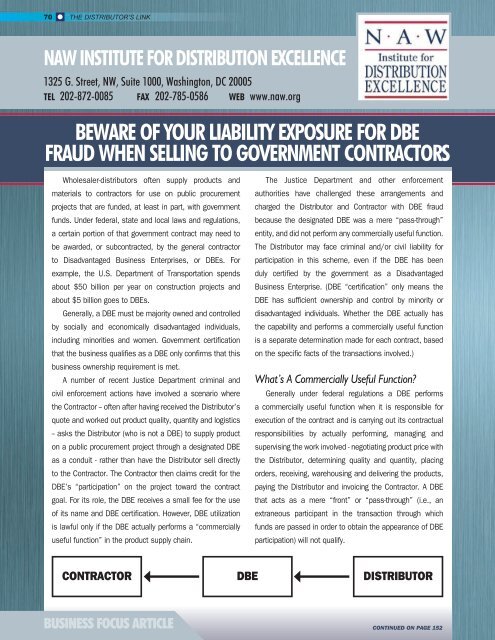SUMMER 2016
Distributor's Link Magazine Summer Issue 2016 / Vol 39 No3
Distributor's Link Magazine Summer Issue 2016 / Vol 39 No3
Create successful ePaper yourself
Turn your PDF publications into a flip-book with our unique Google optimized e-Paper software.
70<br />
THE DISTRIBUTOR’S LINK<br />
NAW INSTITUTE FOR DISTRIBUTION EXCELLENCE<br />
1325 G. Street, NW, Suite 1000, Washington, DC 20005<br />
TEL 202-872-0085 FAX 202-785-0586 WEB www.naw.org<br />
BEWARE OF YOUR LIABILITY EXPOSURE FOR DBE<br />
FRAUD WHEN SELLING TO GOVERNMENT CONTRACTORS<br />
Wholesaler-distributors often supply products and<br />
materials to contractors for use on public procurement<br />
projects that are funded, at least in part, with government<br />
funds. Under federal, state and local laws and regulations,<br />
a certain portion of that government contract may need to<br />
be awarded, or subcontracted, by the general contractor<br />
to Disadvantaged Business Enterprises, or DBEs. For<br />
example, the U.S. Department of Transportation spends<br />
about $50 billion per year on construction projects and<br />
about $5 billion goes to DBEs.<br />
Generally, a DBE must be majority owned and controlled<br />
by socially and economically disadvantaged individuals,<br />
including minorities and women. Government certification<br />
that the business qualifies as a DBE only confirms that this<br />
business ownership requirement is met.<br />
A number of recent Justice Department criminal and<br />
civil enforcement actions have involved a scenario where<br />
the Contractor -- often after having received the Distributor’s<br />
quote and worked out product quality, quantity and logistics<br />
-- asks the Distributor (who is not a DBE) to supply product<br />
on a public procurement project through a designated DBE<br />
as a conduit - rather than have the Distributor sell directly<br />
to the Contractor. The Contractor then claims credit for the<br />
DBE’s “participation” on the project toward the contract<br />
goal. For its role, the DBE receives a small fee for the use<br />
of its name and DBE certification. However, DBE utilization<br />
is lawful only if the DBE actually performs a “commercially<br />
useful function” in the product supply chain.<br />
The Justice Department and other enforcement<br />
authorities have challenged these arrangements and<br />
charged the Distributor and Contractor with DBE fraud<br />
because the designated DBE was a mere “pass-through”<br />
entity, and did not perform any commercially useful function.<br />
The Distributor may face criminal and/or civil liability for<br />
participation in this scheme, even if the DBE has been<br />
duly certified by the government as a Disadvantaged<br />
Business Enterprise. (DBE “certification” only means the<br />
DBE has sufficient ownership and control by minority or<br />
disadvantaged individuals. Whether the DBE actually has<br />
the capability and performs a commercially useful function<br />
is a separate determination made for each contract, based<br />
on the specific facts of the transactions involved.)<br />
What’s A Commercially Useful Function?<br />
Generally under federal regulations a DBE performs<br />
a commercially useful function when it is responsible for<br />
execution of the contract and is carrying out its contractual<br />
responsibilities by actually performing, managing and<br />
supervising the work involved - negotiating product price with<br />
the Distributor, determining quality and quantity, placing<br />
orders, receiving, warehousing and delivering the products,<br />
paying the Distributor and invoicing the Contractor. A DBE<br />
that acts as a mere “front” or “pass-through” (i.e., an<br />
extraneous participant in the transaction through which<br />
funds are passed in order to obtain the appearance of DBE<br />
participation) will not qualify.<br />
CONTRACTOR<br />
DBE<br />
DISTRIBUTOR<br />
BUSINESS FOCUS ARTICLE CONTINUED ON PAGE 152

















